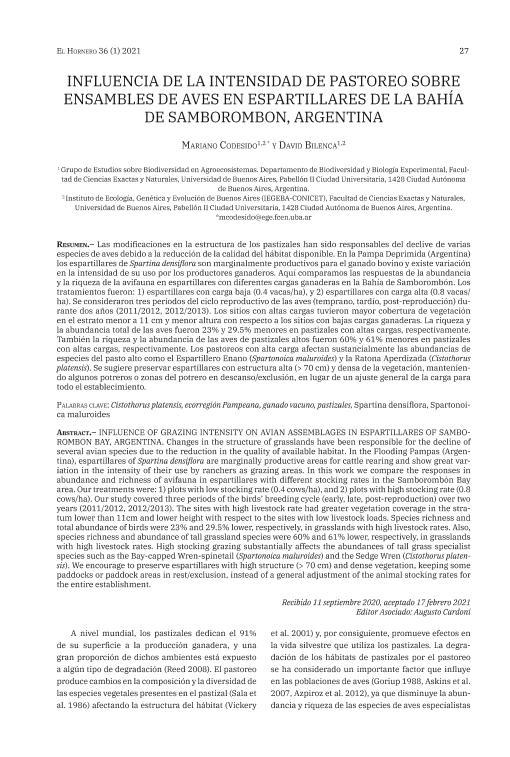Artículo
Las modificaciones en la estructura de los pastizales han sido responsables del declive de variasespecies de aves debido a la reducción de la calidad del hábitat disponible. En la Pampa Deprimida (Argentina) los espartillares de Spartina densiflora son marginalmente productivos para el ganado bovino y existe variación en la intensidad de su uso por los productores ganaderos. Aquí comparamos las respuestas de la abundancia y la riqueza de la avifauna en espartillares con diferentes cargas ganaderas en la Bahía de Samborombón. Los tratamientos fueron: 1) espartillares con carga baja (0.4 vacas/ha), y 2) espartillares con carga alta (0.8 vacas/ha). Se consideraron tres períodos del ciclo reproductivo de las aves (temprano, tardío, post-reproducción) durante dos años (2011/2012, 2012/2013). Los sitios con altas cargas tuvieron mayor cobertura de vegetación en el estrato menor a 11 cm y menor altura con respecto a los sitios con bajas cargas ganaderas. La riqueza y la abundancia total de las aves fueron 23% y 29.5% menores en pastizales con altas cargas, respectivamente. También la riqueza y la abundancia de las aves de pastizales altos fueron 60% y 61% menores en pastizales con altas cargas, respectivamente. Los pastoreos con alta carga afectan sustancialmente las abundancias deespecies del pasto alto como el Espartillero Enano (Spartonoica maluroides) y la Ratona Aperdizada (Cistothorus platensis). Se sugiere preservar espartillares con estructura alta (> 70 cm) y densa de la vegetación, manteniendo algunos potreros o zonas del potrero en escanso/exclusión, en lugar de un ajuste general de la carga para todo el establecimiento. Changes in the structure of grasslands have been responsible for the decline of several avian species due to the reduction in the quality of available habitat. In the Flooding Pampas (Argentina), espartillares of Spartina densiflora are marginally productive areas for cattle rearing and show great variation in the intensity of their use by ranchers as grazing areas. In this work we compare the responses in abundance and richness of avifauna in espartillares with different stocking rates in the Samborombón Bay area. Our treatments were: 1) plots with low stocking rate (0.4 cows/ha), and 2) plots with high stocking rate (0.8 cows/ha). Our study covered three periods of the birds’ breeding cycle (early, late, post-reproduction) over two years (2011/2012, 2012/2013). The sites with high livestock rate had greater vegetation coverage in the stratum lower than 11cm and lower height with respect to the sites with low livestock loads. Species richness and total abundance of birds were 23% and 29.5% lower, respectively, in grasslands with high livestock rates. Also, species richness and abundance of tall grassland species were 60% and 61% lower, respectively, in grasslands with high livestock rates. High stocking grazing substantially affects the abundances of tall grass specialist species such as the Bay-capped Wren-spinetail (Spartonoica maluroides) and the Sedge Wren (Cistothorus platensis). We encourage to preserve espartillares with high structure (> 70 cm) and dense vegetation, keeping some paddocks or paddock areas in rest/exclusion, instead of a general adjustment of the animal stocking rates for the entire establishment.
Influencia de la intensidad de pastoreo sobre ensambles de aves en espartillares de la Bahía de Samborombón, Argentina
Título:
Influence of grazing intensity on avian assemblages in espartillares of Samborombon Bay, Argentina
Fecha de publicación:
10/2021
Editorial:
Asociación Ornitológica del Plata
Revista:
El Hornero
ISSN:
0073-3407
e-ISSN:
1850-4884
Idioma:
Español
Tipo de recurso:
Artículo publicado
Clasificación temática:
Resumen
Archivos asociados
Licencia
Identificadores
Colecciones
Articulos(IEGEBA)
Articulos de INSTITUTO DE ECOLOGIA, GENETICA Y EVOLUCION DE BS. AS
Articulos de INSTITUTO DE ECOLOGIA, GENETICA Y EVOLUCION DE BS. AS
Citación
Codesido, Mariano; Bilenca, David Norberto; Influencia de la intensidad de pastoreo sobre ensambles de aves en espartillares de la Bahía de Samborombón, Argentina; Asociación Ornitológica del Plata; El Hornero; 36; 1; 10-2021; 27-38
Compartir




